
 Screenwriting was one of the first sectors of the film industry to embrace digital technology.
Screenwriting was one of the first sectors of the film industry to embrace digital technology.
Way back in the early 1990s, software packages were being launched which empowered screenwriters to craft their work safe in the knowledge that they could maintain multiple versions, back up important scripts and meet the industry’s tough formatting guidelines.
Cut to thirty years later and now there are dozens of packages available, many offering extra features to help writers with brainstorming, planning and reporting on all aspects of the script.
I thought it would be interesting to take a quick look at the biggest packages on the market and see how they stack up against each other.
I’m going to measure three things:
WE RECOMMEND THE VIDEO: How To Download Copyright Free New Song And Movies For Youtube | Sunday Comment Box91
How to download copyright free new song and movies for youtube | sunday comment box91 hi i am yogi yogendra welcome to our youtube channel ...
- Awareness – Market penetration among screenwriters
- Activity – Percentage of scripts written in each program
- Attitude – What screenwriters think of each program
I’ll be drawing on two sources of data to do this:
 A dataset of 12,309 feature film scripts
A dataset of 12,309 feature film scripts
from my recent collaboration with Screencraft in which we measured the opinions and values of professional script readers. These scripts were either entered into a Screencraft script competition or submitted to receive a script report in 2016, 2017 or 2018.- A survey of 2,128 screenwriters I carried out with Screencraft in January 2019. I asked respondents questions about their professional experience in screenwriting, such as whether they have ever had an agent and how much they have earned from writing. This allowed me to split the screenwriters into two groups: “Professional” and “Aspiring”. (In the real world the distinction is rarely so neat but I felt it was important to provide at least some filtering by experience).
There is more information about both of these sources in the ‘Notes’ section at the end of the article.
Here are the seven packages I have data for (presented in alphabetical order):
- Celtx – $180 annual subscription. Celtx was previously a free, open-source, desktop software but development stopped in 2011 and it was officially discontinued in 2017. It is now a paid, cloud-based subscription service.
- Fade In – $80 purchase. Launched in 2011 and aimed squarely at the top end of the screenwriting industry.
- Final Draft – $250 purchase. Final Draft is the old package, with its first Mac version launching in 1990. PC users got their first release five years later in 1995.
- Movie Magic Screenwriter – $250 purchase. Movie Magic Screenwriter was created by the combination of two older screening programs – ScriptThing and Scriptor (which was awarded an Academy Award for technical achievement in 1994).
- Scrivener –$45 purchase. Launched in 2007 and designed for many types of writers including novelists, journalists and screenwriters.
- Trelby – Free. It was initially launched as a commercial product called ‘Blyte’ in 2003. In 2006 it was renamed and converted into an open-source free product.
- WriterDuet – $89 annual subscription. Launched in 2013, it is currently a cloud-based online tool. Your first three scripts are free, after which you’ll need an annual Pro subscription.
Right, let’s take a look at how they fare…
1. Awareness
Let’s start with brand awareness. Within my survey of over 2,000 screenwriters, I asked respondents whether they had ever used each of the seven major screenwriting programs.
93% of professional screenwriters have used Final Draft, as have 76% of aspiring screenwriters. The second place program is Celtx, which lags behinds at 39% and 49% respectively.
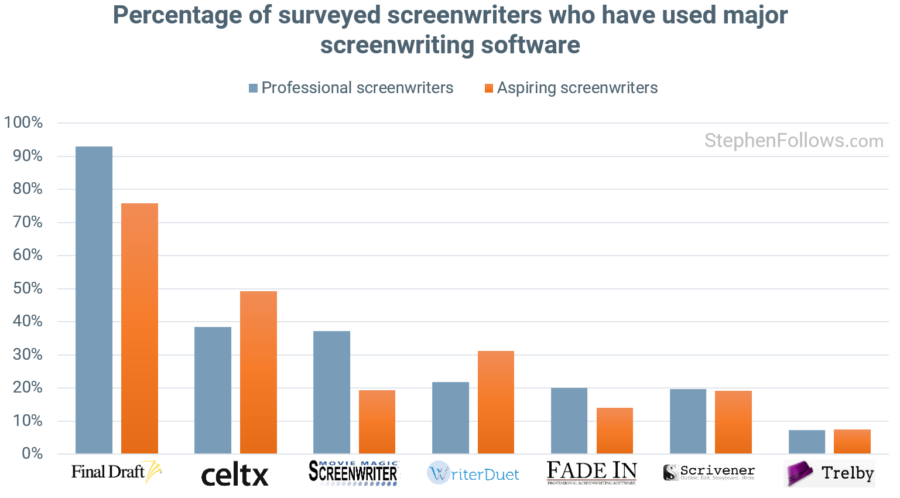
2. Activity
Next, let’s take a look at which is the more frequently used program.
Using metadata in the PDF files, we were able to determine which program was used to write the majority of the over 12,000 scripts in our script readers study. Sadly there were a few programs which did not reveal themselves via this process and so they have not been included in the chart below. I.e. the chart shows percentages of scripts for which we could determine the source program.
Final Draft again tops the pack, with a market share of 59%. Celtx was second at 12%, followed by Movie Magic Screenwriter (8%), WriterDuet (7%) and Fade In (4%). 9% of scripts were written in programs not intended for screenplay creation, such as Word, Pages and, yes, even NotePad.
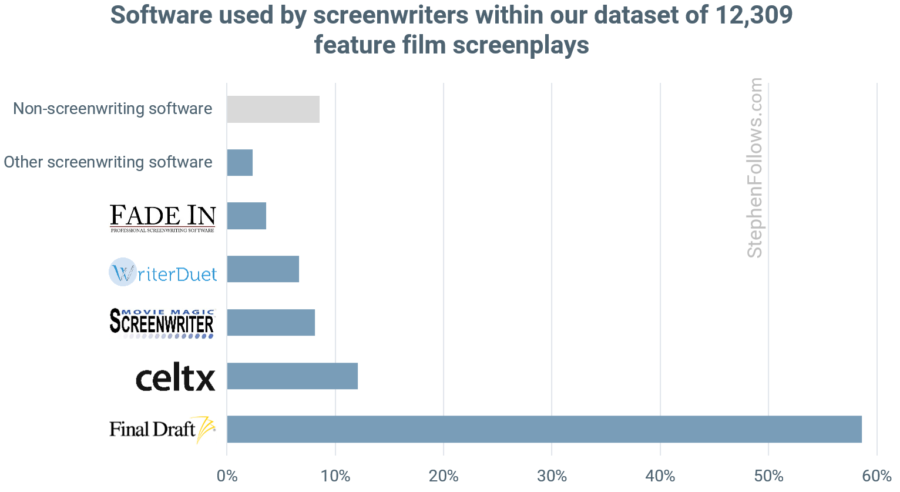
For each script, we have a Review Score, out of ten, given by the professional script readers who reviewed the script.
It will surprise few to learn that scripts written in general word processing programs performed the poorest. That’s not because those programs make scripts worse, but rather because in screenwriting there is a strong link between experience and quality, and one would expect serious screenwriters to have taken the time to acquire a dedicated program to write in.
There is not a huge difference between the top three programs, with scripts written in Final Draft coming out on top with an average score of 5.3 out of 10, Fade In with 5.0 and Movie Magic with 4.9.
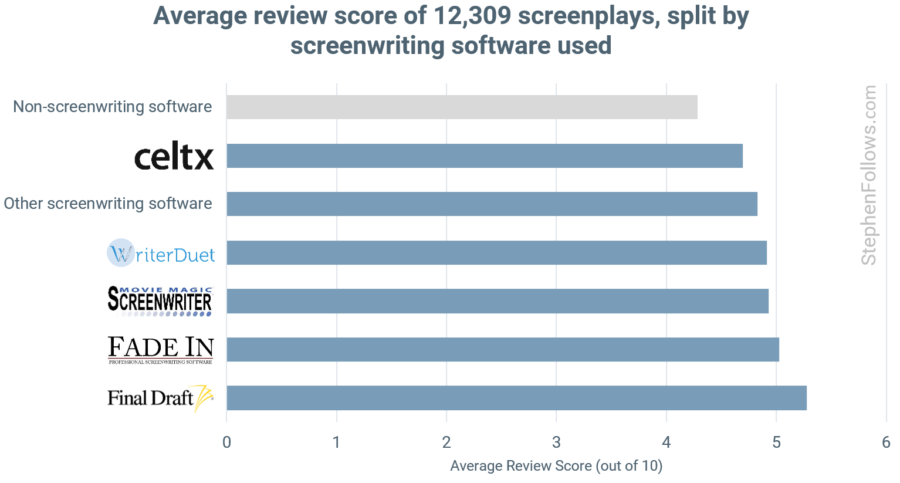
3. Attitude
Finally, let’s take a look at what screenwriters think of each of the major programs.
Of those who had used a program, we asked them to say whether they “loved it”, “kinda liked it”, were indifferent or “hated it”. Maybe by now you will have already guessed which program came out on top…
Yes, Final Draft had the highest percentage of screenwriters saying they “loved” it (52% of people who’d used it) and the lowest percentage of haters (just 4%). WriterDuet came second (37% love, 5% hate) and Fade In third (35% love, 4% hate)
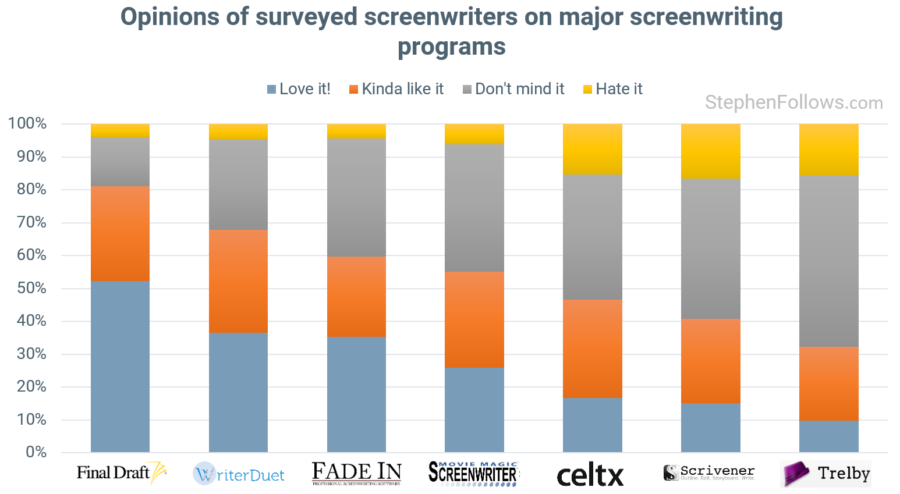
I used this data to create a rough relative score for each program (“love” = two points, “kinda like” = one point and “hate” = minus one) and split the results by the screenwriters’ experience.
The biggest differences between the level of experience were with WriterDuet and Celtx, both of which are preferred by aspiring screenwriters more than by professionals.
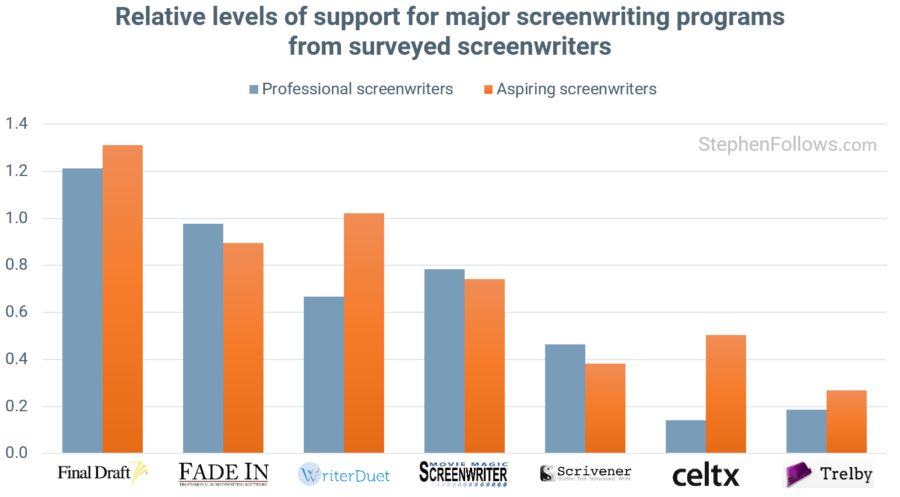
So in all three ways of measuring impact, Final Draft comes out on top. They are certainly the market leaders, although the other major screenwriting packages have many fans and the sector is far from owned by Final Draft.
Notes
The survey data is self-reported answers from people who chose to complete our survey. That adds all manner of biases when compared to the empirical market share data we gleaned from the PDF metadata. 11% of the respondents fall into my definition of “Professionals” and 89% are “Aspiring”.
This is wholly independent research. Just for the avoidance of doubt, here is my Shermanesque statement: I was not paid, rewarded, induced or coerced into writing this article by any party, least of all any screenwriting programs. None of the programs mentioned above were aware of this article before publication and none had any influence on the results. In the course of researching our script readers report, I did chat with technical staff at Celtx and WriterDuet in order to help me understand the metadata their programs create.
Screencraft were essential in providing the screenplays and also helped promote the survey on their networks. The research and number crunching was carried out independently by myself and my report co-authors, Josh Cockcroft and Liora Michlin. This means that the results could not have been influenced in any way by any deals or connections Screencraft may have with script software. That said, they never asked, suggested or even so much as hinted we do anything other than find out what the data reveals and report it faithfully.
Most programs offer discounted pricing for students, teachers, upgrades and bulk purchases. The prices I listed are the current US dollar un-discounted price for the latest version as of the writing of this article.
Celtx is a complicated program to track as it has changed from being a free desktop program to a paid online subscription service. All the scripts we studied were exported between 2016 and 2018 and so we can’t know if they were using the old or new incarnation. Likewise, the views screenwriters shared could be recent or historical.
Other screenwriting packages are available. These ones studied were picked due to a combination of relevance and availability of data. This market snapshot takes no account of the features, quality or cost of each program – it’s simply reflecting the views and actions of screenwriters. Each program offers a different writing experience, so if you’re currently deliberating over which program to use I would highly recommend trying each and going with whichever works best for you. It doesn’t matter what everyone else uses and no matter how well coded a piece of software is, it cannot make you a better writer in any meaningful sense.
14 Comments
Jonathan Sieff
March 11, 2019 @ 11:32 am
I use Final Draft 11 and Fade In.
Final Draft is great and has a tons of features that let writers both Aspiring and Professional learn new skills and develop existing ones.
Fade In has the same features as Final Draft but also converts scripts written using other software (and even PDFs) to Fade In. This makes editing scripts much easier.
James Madara
March 11, 2019 @ 1:52 pm
One thing to mention, while MovieMaker has not been updated in several years. I would consider it vaporware at this point.
Hi James. Maybe so, although in the past packages have been dormant for a while and then sprung back to life. There were five years between some Final Draft versions, Celtx has completely transformed and Trelby has had two phoenix moments (going open-source and more recent extra development). So we may get see Movie Magic rise again.
Steve George
March 12, 2019 @ 1:23 am
I would like to know, given the overall industry activity with the given software, what the pros consider the must. I’d expect a studio or a reader would want to hear, understand, serious writers using one said software package over another. Personally I would not risk using anything but FinalDraft is your dealing with peers in the industry.
Robert Blalack
March 11, 2019 @ 2:42 pm
Surprising that Final Draft scores so far up the ladder. Screenwriter 2000 is a far more efficent program. But Tradition helps sooth Hollywood’s anxiety, so Final Draft persists.
Could I ask if you can do, or have done, a survey of how many writers go on to have a second screenplay produced? You did this for directors, and the results are fascinating.
Hi Robert. Personally, I’ve heard more people complain about Final Draft than any other program. I always put this down to problems with FD but now I have to revise that and say that if most people use it then it’s more likely I will hear complaints about it than any other package, even if it’s pretty good. It’s exactly this just of issue in which data can be so useful – moving away from personal, anecdotal perspectives and shifting to an objective, global viewpoint.
Yes, I will be doing the same work on writers, later in the year.
Sarah Nicole Faucher
December 20, 2019 @ 2:51 pm
Two of my mentors advised me to use Movie Magic Screenwriter and I have not regretted it since. Two fellow screenwriters were pressured to use Final Draft by producers and they have regretted it ever since. Their complaints are the same – the software program is not intuitive like MMS. I know of one filmmaker who uses all MMS software including Movie Magic Budgeting and Movie Magic Scheduling. He bought a writer’s Final Draft script a few years ago and converted that script easily on Movie Magic Screenwriter. Personally, I have noticed that Final Draft has always had better marketing power than Movie Magic Screenwriter. Perhaps this is why Final Draft is pushed by the vast majority of producers.
Is it just me, but with Fd 9 when I slag off religion or the government, the programme plays up?
I love Scrivener. I do all my thinking, creating, collecting ideas, research, gathering of images in Scrivener. It almost becomes a director’s notebook for me. I also love its companion program Scapple for idea mapping and story mapping. I use Final Draft when I want to use its production tagging tools.
Thank you, Stephen. The work you do is fascinating.
Hmm… Makes me want to check out Scrivener. For me, I’m currently using and love Highland 2. Designed by screenwriters and so. damn. simple.
This article won’t make me switch to Final Draft, but I certainly appreciate the insights!
Richard Abbott
March 18, 2019 @ 11:36 pm
Great piece! I’m surprised nobody mentioned “Script Studio”. It’s been around since 2004 (used to be called Movie Outline). I’ve used it since 2007. Cool software.
I used to coordinate production revisions, tracking drafts of projects in development, etc. for DreamWorks in live action features.
We tried to work with Final Draft but it was too clumsy. We went with ScriptThing->MM Screenwriter because they were willing to implement features that were fantastic for handling production/locked pages.
It’s been awhile since I have checked? so maybe Final Draft has caught up? But since they have the market share, I doubt they have.
I do wish Screenwriter would update. One of my favorite features is assigning computer voices and having the script read back to you.
Andrea
January 7, 2020 @ 6:37 am
It would be interesting to see a similar study on the scheduling and budgeting software.
When I taught ‘Producing’, the University I worked for recommended Final Draft to students as the industry standard and purchased many licenses, annually, for their screenwriting labs.
I’m not a producer working in LA – but I do wonder if Final Draft is, in fact, the industry standard for professional screenwriters in the writer’s guild there?
And then I wonder about the studios and production companies – do they like MMS so they can incorporate it with the MM scheduling and budgeting? If not, what is their work flow like?